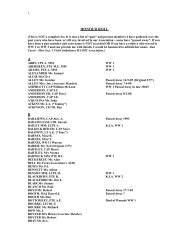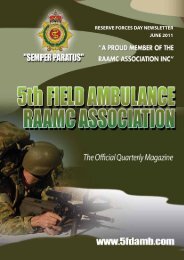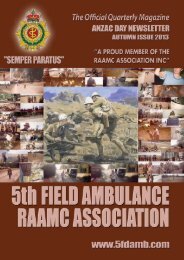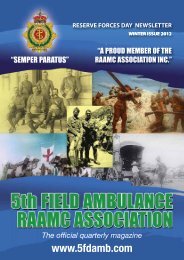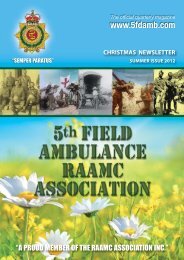2010 Paulatim Magazine - RAAMC Association
2010 Paulatim Magazine - RAAMC Association
2010 Paulatim Magazine - RAAMC Association
Create successful ePaper yourself
Turn your PDF publications into a flip-book with our unique Google optimized e-Paper software.
Unlike conventional Mission Rehearsal Exercises (MRE), SOCOMD<br />
medical personnel have considerable involvement in the overall<br />
strategic outcomes of SOTG MREs. This can be attributed to SOTG<br />
commanders at all levels embracing the force enhancement capabilities<br />
of the medical element not only on the battlefield but also in the force<br />
preservation space. Apart from the provision of general health care that<br />
keeps the operator in the fight, during the exercise, medical elements<br />
form an integral embedded component of the assault teams in the<br />
conduct of operational full mission profiles.<br />
PAULATIM<br />
During the deployment, SOCOMD medical personnel are exposed to a<br />
unique operating tempo and culture. Some of the key lessons we have<br />
learned on a posting to SOCOMD have been:<br />
Garrison patient work includes shoulder dislocations, ATV rollovers,<br />
suturing, suspected viral meningitis and facial fragmentation injuries to<br />
name a few. Due to the large amount of musculoskeletal injuries, SOTG<br />
has its own physiotherapist. These presentations result from the nature<br />
of employment of the Field Elements we support.<br />
Whilst the primary role of the medic is to provide emergency and<br />
primary health support to the fighting force, they are also commonly<br />
called upon to conduct ‘med caps’. A med cap is a ‘sick parade’ for local<br />
nationals and allows ADF personnel to build rapport with local villagers.<br />
The common methods of insertion are vehicle and helicopter operations,<br />
followed by foot mounted patrolling.<br />
Medics often deploy on vehicle or helicopter mounted operations.<br />
We use the Bushmaster vehicle. Whilst on vehicle operations, medics<br />
man guns and are employed as vehicle commanders. The use of<br />
airframes for patrols usually involves landing at a secure landing zone<br />
(LZ), followed by a few kilometre patrol to the target area. After the air<br />
insertion, the walk over some of the harshest country, carrying your life<br />
and medical life support tools on your back for a period of hours to<br />
weeks is no easy feet.<br />
One of the most professionally rewarding tasks allocated to SOTG<br />
medics is Operation VOODOO. These missions are arranged by the SOTG<br />
to allow medics the opportunity to work on the American Aero Medical<br />
Evacuation (AME) birds. Some of the missions we deploy on include<br />
responding to point of injury (POI) casualties, mass casualties, coalition<br />
FOB’s and patient transfers to and from Kandahar.<br />
For those who are not aware of the term forward surgical team, it is a<br />
US term for a level 2 health facility that offers resuscitation (4 tables),<br />
imagery (x-ray & fast scans), surgery (2 tables), intensive care (2<br />
beds) and a small holding capability (8 beds). The facility which we<br />
worked in at TK was run by both US Air Force and Navy. The clinical<br />
work we undertook included but was not limited to anaesthetics in<br />
surgery, working in the resuscitation bays and treating local nationals<br />
during local clinics. Honestly, one of the most clinical hands-on areas<br />
the majority of us have worked.<br />
Deploying on operations as part of an SOTG is the highlight for all<br />
<strong>RAAMC</strong> personnel employed within SOCOMD. For us it culminates years<br />
of military and medical training in an operational environment, pushing<br />
them to the end of their physical, mental and medical limits. <strong>RAAMC</strong><br />
personnel are currently on their 13th rotation with the SOTG of which<br />
no two have been the same. The lessons are passed on to each member,<br />
resulting in <strong>RAAMC</strong> personnel have been awarded Nursing Service<br />
Crosses (NSC), the Medal of Gallantry (MG), Commanders Citations and<br />
a range of other Australian Defence Force Commendations for their<br />
service.<br />
Little by Little<br />
Outdated but still followed<br />
The Royal Australian Army Medical Corps comes from a long and proud<br />
history with linkages dating as far back as the First Fleet in 1788 to the<br />
New South Wales Medical Staff Corp in 1854 and to the birth, as we<br />
know it, of the <strong>RAAMC</strong> in 1901. Along with the formation of the <strong>RAAMC</strong><br />
came the <strong>RAAMC</strong> Badge with a well-known Latin phrase <strong>Paulatim</strong> ‘Little<br />
by Little’. This appropriate Latin phrase was a modest expression of the<br />
<strong>RAAMC</strong>’s slowly developing skills and capabilities. I propose that<br />
Military Medicine especially, has progressed a long way, yet the <strong>RAAMC</strong><br />
is still only progressing ‘Little by Little’.<br />
The <strong>RAAMC</strong> does not have a centralised collation of all medical lessons<br />
learnt on operations and back home. Many of us ‘re-invent the wheel’<br />
developing new medical equipment, medical SOP’s (Standard Operating<br />
Procedures) or training and development ideas when the equipment<br />
has already been built and trailed. I believe there are many lessons<br />
that are interchangeable from unit to unit, man to man and even from<br />
the ADF Tri-services. I propose a controlled and organised medical<br />
database managed by the Army Logistical Training Centre (ALTC) Health<br />
Service Wing (HSW) and accessed via DRN would provide the repository<br />
of knowledge required providing easy access for all <strong>RAAMC</strong> and RAANC<br />
personnel to up-to-date medical advice and support from Subject Matter<br />
Experts. The data base would also assist Training and Development Cells<br />
in obtaining insight, feedback and advice on medical equipment,<br />
medical SOP’s and lessons learnt on operations and back home. A web<br />
page orientated medical database would stop ‘re-inventing the wheel”.<br />
PA U L AT I M – M A GAZINE O F T HE R OYA L A U S T R A L I A N A R M Y M E DICAL C O R P S – 2 0 1 0 9 7



